The Public Life of Sherlock Holmes: The Science Fictional Humphrey Bogart
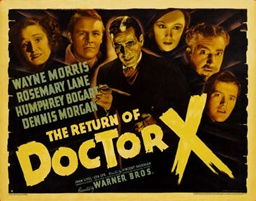 Into the nineteen fifties, Hollywood operated under the studio system. A few major movie studios owned both the production and distribution channels and dominated the industry.
Into the nineteen fifties, Hollywood operated under the studio system. A few major movie studios owned both the production and distribution channels and dominated the industry.
They cranked out “B” pictures to provide product to support the “A” films and keep the theaters they owned filled.
Actors, especially non-stars, made several films a year, either appearing higher in the credits on B films or as supporting actors in A movies. Those actors had very little power in the system as well.
In 1936, Humphrey Bogart (who had already twice failed to stick in Hollywood) received his first critical acclaim for The Petrified Forest, in which he recreated his Broadway role as gangster Duke Mantee.
He would really strike it big in 1941, first with High Sierra, and then The Maltese Falcon (if you haven’t seen this one, rent it tonight and then leave an apology comment on this post for waiting so long). In the five years between Forest and Sierra, he appeared in twenty-nine films: most not as the star.
Bogart famously said, “I made more lousy pictures than any actor in history.” This was because Warner Brothers tossed him into every low budget B movie they could.
Sometimes it was so bad that he refused the part, which then got him suspended without pay. That’s why you see Dennis Morgan and not Bogie in the awful western, Bad Men of Missouri (with Wayne Morris starring – see below).
Bogie, in a career with over eighty credits and possibly the greatest star in film history, made only one horror/science fiction movie. And he considered it one of his worst. He’s got a point.
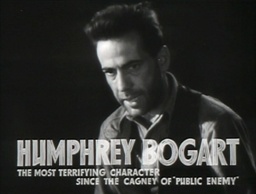
His sixth film in 1939 was The Return of Doctor X. It had nothing to do with 1932’s risqué Doctor X: Warner Brothers was just trying to cash in on the earlier movie.
Bogart had to be disappointed, having just co-starred in the successful crime drama, The Roaring Twenties. And before that, he’d gotten some of his best reviews opposite Bette Davis in Dark Victory.
Most assuredly, The Return of Doctor X wasn’t going to be nominated for any Academy Awards. Wayne Morris is actually the star of the film and Dennis Morgan had a bigger part than Bogart, who was third-billed (below Morris and Rosemary Lane).
Visually, this is classic campy science fiction. It’s got that thirties/forties sci-fi look, with bubbling beakers, test tubes, and electrical experiments in a laboratory. And of course, a mad scientist behind it all. Any doctor with a monocle and a van dyke is probably up to no good!
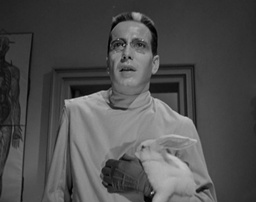
Humphrey Bogart makes quite a distinctive appearance shortly after the 23-minute mark. He’s really a skunk…
SPOILERS SPOILERS SPOILERS (though honestly, I don’t think knowing this is going to change your viewing experience)
Hayseed reporter Walter Garrett (Morris) finds a popular actress dead in her hotel suite and gives himself a front-page scoop. Except that she shows up at the newspaper offices the next day, looking pale and threatening to sue.
The now-fired Garrett and his doctor buddy, Michael Rhodes (Morgan) investigate and find out that Dr. Frances Flegg (John Litel) can raise the dead and is trying to create a synthetic blood that will sustain these not-so-dead folks.
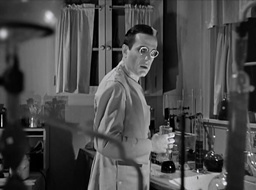
Flegg’s assistant, Marshall Quesne (Bogart) was actually the executed Doctor X, back from the dead (I’m not making this up!). He’s running around killing people and draining their blood to sustain himself. Garrett and Rhodes figure things out and hunt down X. The final confrontation actually resembles one of Bogart’s gangster flicks, which is rather amusing in light of this film being what it is.
END OF SPOILER
Bogart hated this film for the rest of his career, saying, “This is one of those pictures that made me march in to (Warner Brothers boss Jack L. Warner) and ask for more money again.”
“You can’t believe what this one was like. I had a part that somebody like Bela Lugosi or Boris Karloff should have played.”
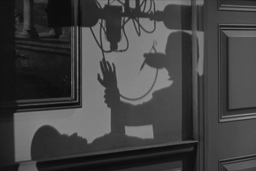
“I was this doctor, brought back to life, and the only thing that nourished this poor bastard was blood. If it’d been Jack Warner’s or Harry (Warner’s) blood, I wouldn’t have minded as much. The trouble was, they were drinking mine and I was making this stinking movie.”
Morris provides comic relief as the lead while Bogie is the bizarre lab assistant with clammy hands and carries a rabbit. It’s an odd film and I suspect that Jack Warner was annoyed with Bogart (he usually was) and stuck him in the part as a punishment.
In a stellar career, albeit with some stinkers, The Return of Doctor X stands out on the Humphrey Bogart resume. He even made a couple of comedies, but only one science fiction/horror flick.
Bogart is my favorite actor and I’ve got almost every film he ever appeared in, but this one is a tough watch unless you’re going totally camp.
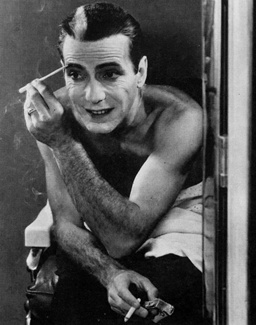
Bogart Trivia – Bogart made seven films in 1937 and repeated the trick again in 1939. How many actors today make seven films a decade? The studio system cranked out films in weeks, not months and years.
In those 7 films of 1939, he was gunned down in five of them. He wasn’t quite “Bogie” yet.
Bob Byrne founded www.SolarPons.com, the only website dedicated to the ‘Sherlock Holmes of Praed Street’ and blogs about Holmes and other mystery matters at Almost Holmes.
He has also written what some say (okay, only him) is the finest essay ever on Bogie: How George Raft Made Humphrey Bogart a Star. You could not make up the story for that one.
[…] Swing over to Black Gate for my latest Monday installment. I look at not one of the better films from my favorite actor, Humphrey Bogart. Here’s a preview… […]
And in the unimaginable event that Black Gate ever needs an in-house Bogart guy, I’ll be him. He made some bad films, and he’s not great in every role, but just about every Bogie film is watchable at least once.
Five of his lesser known films I highly recommend: All Through the Night, Deadline USA, Bullets or Ballots, We’re No Angels and Across the Pacific (this is actually a ‘big’ film, but as a ‘missed it by that much’ from being a standout, it doesn’t get a lot of attention).
I just saw this for the first time a year or two ago, and loved it. It’s a real mash-up, a horror/gangster/snappy newsroom blend in the best Warner Brothers fashion. It’s certainly not art and you can’t blame Bogart for hating it, but you can’t tell that’s how he felt from watching it. Consummate pro that he was, he gives the role the best he’s got and doesn’t condescend to the character or the movie.
@emcgargle – Definitely agree that Bogart never gave less than 100%. I’ve seen Return twice and it’s certainly different. I didn’t quite get Wayne Morris’ silliness in the first one. I thought that Dennis Morgan had the best performance in this one. It was his first film at Warners and helped move him up to leading role status.
Bob, I have to confess to a fondness for Wayne Morris – he was just such a big lug. My favorite film of his is 1937’s Kid Galahad (aka Battling Bellhop) with Bette Davis and Edward G. Robinson.
@EMC – yeah, he was a big lug. I like a few of his westerns. Especially Two Guns and a Badge. He’s a pretty typical product of the studio system. Decent actor who spent his career in B films.
I hate to admit this, but I never thought much of Bogart as an actor until I actually read Hammett’s “The Maltese Falcon.” Before that, I thought of Bogie as one of those popular actors who made a career of playing themselves. But after reading the novel, I saw Bogie’s genius. On screen he wasn’t just playing another tough detective, nor was he simply portraying a version of himself. No, he WAS Sam Spade, through and through, bringing Hammett’s character to life.
I did not see a Bogart film until my early twenties, I think. Then I saw Casablanca on a big screen at a theater on the National Landmark of Historic Places. I was blown away.
BTW, The Maltese Falcon is both the best private eye novel and private eye film. It’s a future post.
This movie will be on Turner Classic Movies this coming Thursday, July 14, at 3:30 PM EST.
You really should see it once if you like Bogie at all.